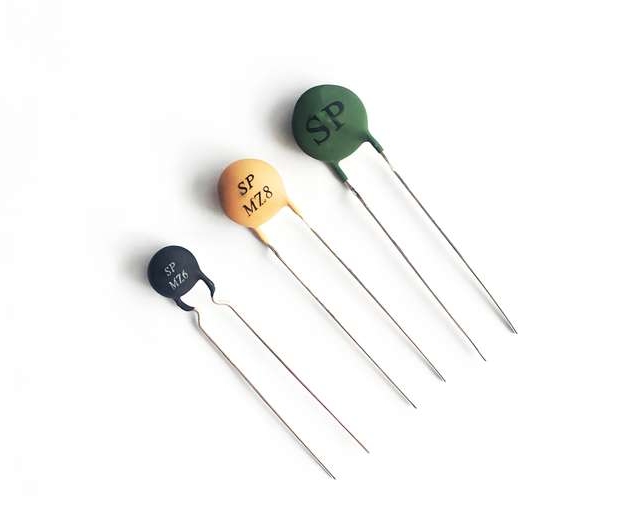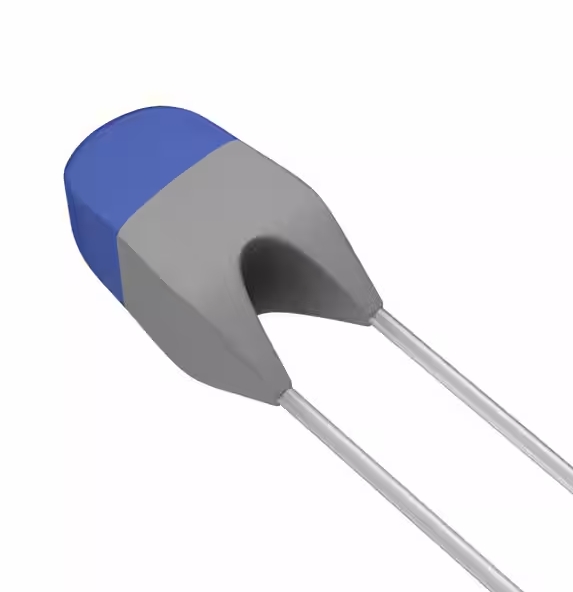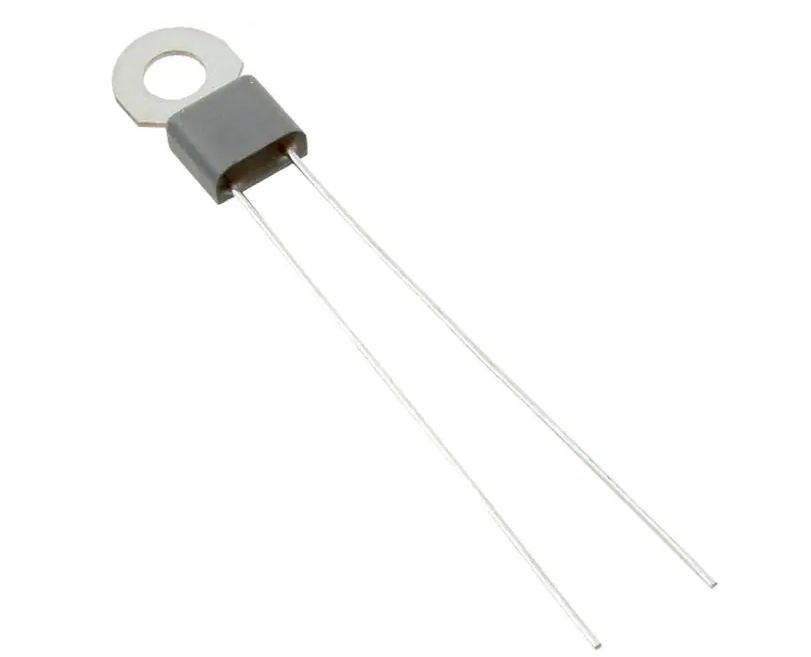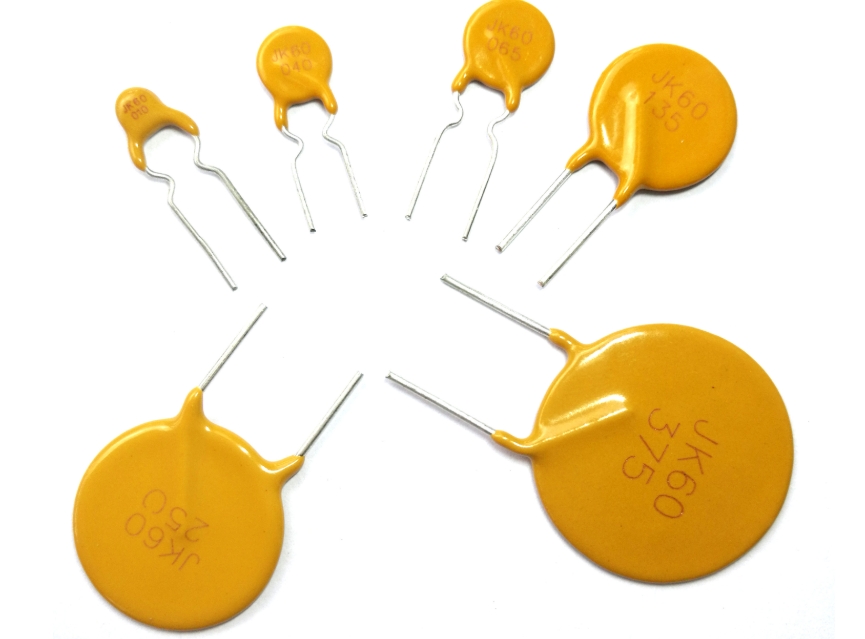Table of Contents
What is PTC Thermistor
PTC thermistor, known as Positive Temperature Coefficient Thermistor, is a typical semiconductor resistance with temperature sensitivity. When the temperature exceeds its Curie temperature, the resistance value of PTC thermistor will increase stepwise with the increase of temperature; the higher the temperature, the higher the resistance value.
PTC Thermistor Characteristics
Self-recovering protection function: When the temperature rises due to overloading, blocking, or short-circuiting of the equipment, the resistance value of the PTC thermistor will increase sharply, thus limiting the current and protecting the equipment from damage. When the fault is removed and the temperature drops, the PTC thermistor will automatically return to a low resistance state, no need to manually reset or replace the component.
Sensitive temperature response: PTC thermistor is very sensitive to temperature changes, can quickly sense the abnormal temperature rise, and timely activation of the protection mechanism, reducing the risk of equipment damage
Simple structure, easy to install: compact size, easy to embed in the equipment, and no complex control circuit, can be directly connected to the equipment circuit
High reliability, long life: able to work stably in high-temperature environments, high-temperature resistance, strong shock resistance, and applicable to various harsh working conditions.
Energy saving and environmental protection: low power consumption under normal operating conditions, no mercury, lead, and other harmful substances, in line with environmental requirements
PTC Thermistor Symbol
The symbol of PTC thermistor is a simple graphic symbol, usually expressed as a rectangle with a “+” symbol, and sometimes there will be “PTC” on the “+” symbol. This symbol visualizes the positive temperature coefficient characteristic of PTC thermistor, i.e., the resistance value increases with increasing temperature.

What is the use of a PTC thermistor?
PTC thermistor (Positive Temperature Coefficient thermistor) is a kind of semiconductor resistor with temperature sensitivity, and its main uses include overcurrent protection, overheat protection, and constant temperature heating.
Overcurrent Protection
PTC thermistor plays the role of overcurrent protection in the circuit. When the current in the circuit exceeds the set value, the resistance value of the PTC thermistor will increase dramatically, thus limiting the passage of current and protecting other components in the circuit from damage. This characteristic makes PTC thermistors widely used in power transformers, various chargers, instruments and other applications requiring overcurrent protection.
Thermal Protection
PTC thermistors also have the function of overheating protection. When the temperature of the equipment or circuit rises due to overload or short-circuit, the resistance value of the PTC thermistor will increase rapidly, thus cutting off the circuit and preventing equipment damage or fire, and other safety hazards. This characteristic makes PTC thermistors widely used in motor protection, battery management systems, and other fields.
Constant Temperature
PTC thermistors can also be used to generate heat at a constant temperature. By controlling the current, PTC thermistors can automatically reduce the current when the set temperature is reached, thus maintaining a constant temperature. This characteristic makes it used in electric blankets, baby warmers, and other electrical appliances that need constant temperature control.
Operating Principle of PTC Thermistors
The working principle of PTC thermistor is based on the positive temperature coefficient effect (PTC effect) of the material; when the temperature rises, its resistance value will increase significantly. This characteristic makes PTC thermistors have a wide range of applications in automatic control circuits, such as for overheating protection and temperature control. In addition, PTC thermistors also have self-recovery characteristics and are commonly used in the manufacture of overcurrent protection devices, such as self-recovery fuses.
In practice, PTC thermistors are usually used in series in circuits to prevent damage to the circuit caused by excessive current or high temperature. This kind of components in the temperature rise resistance increases, thus limiting the current, play a protective role; when the temperature decreases, the resistance value decreases, and the components can automatically restore the working state.
Positive Temperature Coefficient Effect
Linear and non-linear PTC effects:
Most of the metal materials (such as copper, aluminum) have a linear PTC effect, the resistance increases slowly with temperature.
The non-linear PTC effect is found in polymer or ceramic materials: when the temperature exceeds the Curie temperature, the resistance value rises sharply in a narrow temperature range, e.g., the resistance of polymer PTC (PPTC) can increase by several to a dozen orders of magnitude.
Working Mechanism and Material Differences
Polymer PTC (PPTC):
Made from materials in which conductive particles are dispersed in a polymer matrix. Normal temperature, conductive particles to form a pathway, low resistance; when the current is too large to cause the temperature rise, the matrix expands so that the conductive particles sare eparated, resistance increases suddenly, blocking the current. After the fault is lifted, the temperature decreases, and the matrix shrinks to restore the pathway.
Ceramic PTC (CPTC):
The main component is semiconductor ceramics such as barium titanate. At low temperatures, the potential barrier of the grain boundary is low, and electrons can easily pass through; at high temperatures, the potential barrier of the grain boundary rises, hindering the movement of electrons, and the resistance rises sharply.
Energy balance and self-recovery characteristics
Under normal operating conditions, the heat generated by PTC is balanced with the heat dissipated to maintain a low resistance state.
Overcurrent protection: When the current increases abnormally, the accumulation of heat causes the temperature to exceed the Curie temperature, and the resistance increases abruptly to limit the current. After troubleshooting, the temperature drops, and the resistor automatically returns to a low resistance state without replacement.

Difference between NTC Thermistor and PTC Thermistor
The main differences between NTC thermistors and PTC thermistors are the characteristics of their resistance value with temperature, material composition, application scenarios, and other performance characteristics.
Characteristics of Resistance Value Changing with Temperature
NTC thermistor: As the temperature rises, its resistance value decreases. This means that the resistance of NTC thermistors is inversely related to temperature.
PTC thermistor: As the temperature rises, its resistance value increases. This means that the resistance of PTC thermistors is directly proportional to the temperature.
Material Composition
NTC thermistors: They are usually made of semiconductor materials such as manganese oxide, nickel oxide, or other similar compounds. These materials have a high resistance at low temperatures, which gradually decreases as the temperature increases.
PTC thermistors: usually made of ceramic materials, such as barium titanate. These materials have low resistance at normal operating temperatures, but the resistance increases dramatically when the temperature exceeds a specific threshold.
Application Scenarios
NTC Thermistors: Commonly used in temperature measurement, temperature compensation, overheat protection, and temperature control circuits. It can be used to suppress inrush current and protect electrical equipment such as TVs, computers, etc,. from damage in situations such as power-on etc. NTC thermistors have a faster response time and are suitable for applications that require a quick response to temperature changes.
PTC Thermistors: Commonly used for overcurrent protection, self-recovery fuses, heating elements and temperature control. When the temperature of an electrical device exceeds a set value, the resistance of the PTC thermistor will increase dramatically, thus limiting the current and protecting the electrical device from damage. The slow response characteristics of PTC thermistors may be advantageous in some applications.
Other Performance Characteristics
NTC thermistors: typically lower cost, suitable for mass production and cost-sensitive applications. May be more sensitive to humidity and chemicals, and require protection in specific environments. May exhibit slight resistance drift in long-term applications.
PTC thermistors: may be more costly, but this additional cost is worthwhile in applications requiring high reliability and safety. They typically have better long-term stability and longer life. Better tolerance to environmental factors and able to maintain stable performance under harsh conditions.
PTC Thermistor Applications

PTC thermistors are widely used in many fields, mainly including the following aspects:
New Energy Vehicles: PTC thermistors are mainly used for motor protection and battery management systems in new energy vehicles. When the temperature of the motor rises suddenly due to overload or poor heat dissipation, the resistance value of the PTC thermistor will increase in a stepwise manner, which automatically cuts off the circuit and prevents the motor from burning. In addition, it can also be used in battery management systems to prevent abnormal temperature rises caused by short circuits or overcharging of batteries, limiting the current and triggering protection mechanisms to prevent thermal runaway.
Small electrical equipment: PTC thermistors are also widely used in small electrical equipment, such as air warmers, soldering irons, shoe dryers, and so on. Due to its small size and low energy consumption, PTC thermistor can realize the effect of fast heating, low energy consumption, and small space occupation in these types of equipment.
Industrial field: In the industrial field, PTC temperature sensors can be used for temperature measurement and control, and as overheating protection elements. For example, in the heater, soldering iron, drying cabinet, air conditioning and other equipment, PTC temperature sensors can accurately measure and control the temperature, to ensure that the equipment in the set temperature range of stable operation, while preventing equipment overheating damage.
Automotive: In the automotive field, PTC temperature sensors are used to detect and regulate the temperatures of certain automotive components, such as the engine and brake system. By monitoring the temperature of these components, overheating problems can be detected and dealt with promptly to ensure the safety and reliability of the automobile. In addition, it is also used for temperature control of automobile air conditioning systems to improve ride comfort.
Civilian equipment: In civilian equipment, PTC temperature sensors are used to control the water temperature of instantaneous water boilers, air conditioners and cold storage temperatures. It can accurately measure and regulate the temperature to meet the needs of people’s daily life.
Electronics: In the field of electronics, PTC temperature sensors are used in electronic positioners and thermal switches as temperature-sensitive components to realize precise temperature control and protection. In addition, PTC materials can also be used for overcurrent protection, limiting the passage of current and protecting the safety of circuits and equipment.
